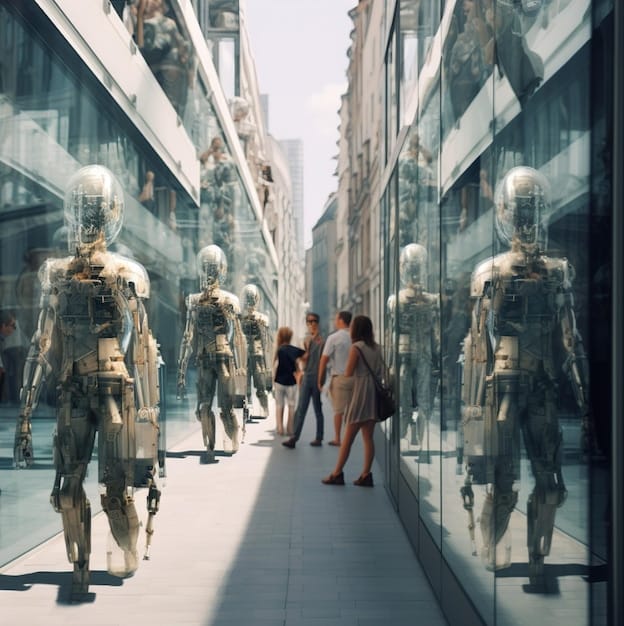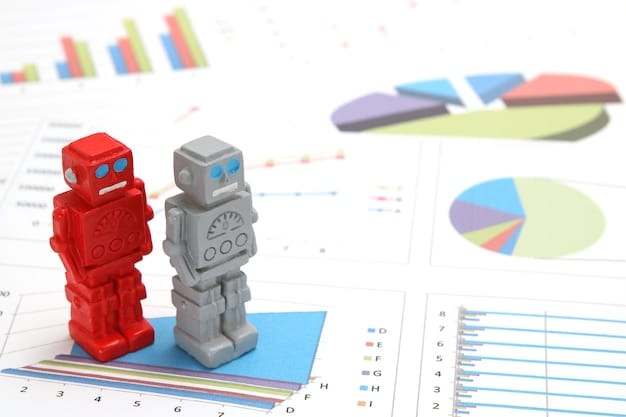The Future of Work in the US: AI and Automation’s Impact

The future of work in the US is being reshaped by AI and automation, leading to shifts in required skills, job displacement in some sectors, and the creation of new opportunities in others, demanding workforce adaptation and strategic planning.
The landscape of employment in the United States is undergoing a seismic shift, driven by the rapid advancements in artificial intelligence (AI) and automation. This transformation, while promising increased efficiency and productivity, also presents significant challenges and uncertainties for the American workforce. Understanding the impact of the future of work in the US: how AI and automation are transforming the job market is crucial for businesses, policymakers, and individuals alike.
The Rise of AI and Automation in the US Economy
The integration of AI and automation technologies into various sectors of the US economy is no longer a futuristic concept but a present-day reality. From manufacturing and logistics to customer service and healthcare, AI and automation are streamlining processes, reducing costs, and improving efficiency. This widespread adoption is fundamentally altering the nature of work and the demand for different skill sets.
AI’s capacity to analyze vast datasets, automate repetitive tasks, and even augment human decision-making is driving a wave of innovation across industries. Automation, powered by robotics and sophisticated algorithms, is taking over tasks previously performed by human workers, leading to both concerns about job displacement and opportunities for increased productivity.
Key Areas of Automation Implementation
Several sectors are experiencing rapid automation, impacting employment and requiring workforce adaptation:
- Manufacturing: Robots and automated systems are increasing production speed and reducing labor costs.
- Transportation: Self-driving vehicles and automated logistics are poised to revolutionize the movement of goods and people.
- Customer Service: Chatbots and AI-powered virtual assistants are handling customer inquiries and support requests.
- Healthcare: AI is assisting with diagnosis, treatment planning, and administrative tasks, improving patient outcomes and reducing costs.
These implementations are not just about replacing human workers; they also create opportunities for new roles that require skills in AI development, maintenance, and data analysis. The challenge lies in ensuring that the workforce is equipped with the necessary training and education to adapt to these changing demands.

Impact on Different Job Sectors
The impact of AI and automation is not uniform across all job sectors. Some industries are experiencing significant job displacement, while others are seeing the emergence of new roles and opportunities. Understanding these sectoral differences is crucial for developing targeted strategies to mitigate negative impacts and capitalize on positive trends.
Sectors that rely heavily on routine, repetitive tasks are particularly vulnerable to automation. Jobs in manufacturing, transportation, and administrative support are likely to see the most significant displacement. However, sectors that require creativity, critical thinking, and complex problem-solving skills are expected to be more resilient and may even benefit from AI and automation.
Vulnerable Job Categories
Certain job categories face a higher risk of automation due to their reliance on routine tasks and predictable processes:
- Data Entry Clerks: AI-powered systems can automate data input and processing tasks.
- Assembly Line Workers: Robots are increasingly capable of performing complex assembly operations.
- Truck Drivers: Self-driving trucks could eventually replace human drivers in long-haul transportation.
- Customer Service Representatives: Chatbots and virtual assistants can handle basic customer inquiries.
The displacement of workers in these job categories necessitates proactive measures to provide retraining and support, enabling them to transition to new roles that are less susceptible to automation.
The Skills of the Future: Adapting to AI and Automation
As AI and automation reshape the job market, the skills required to succeed are also evolving. Traditional skills are becoming less relevant, while new skills that complement AI and leverage automation are gaining importance. Developing a workforce with the skills of the future is essential for maintaining competitiveness and ensuring economic prosperity.
The focus is shifting from routine, manual tasks to skills that require critical thinking, creativity, emotional intelligence, and adaptability. These skills are essential for collaborating with AI systems, solving complex problems, and innovating in a rapidly changing environment.
Essential Skills for the Future Workforce
To thrive in the age of AI and automation, workers will need to develop the following skills:
- Critical Thinking: The ability to analyze information, evaluate arguments, and make sound judgments.
- Creativity: The capacity to generate new ideas, solve problems in innovative ways, and adapt to changing circumstances.
- Emotional Intelligence: The ability to understand and manage emotions, build relationships, and collaborate effectively with others.
- Technical Skills: Proficiency in using and understanding AI tools, data analytics, and other emerging technologies.
Investing in education and training programs that focus on these skills is crucial for preparing the workforce for the challenges and opportunities of the future.
The Role of Education and Training
Education and training institutions play a critical role in preparing the workforce for the future of work. Traditional educational models need to be adapted to incorporate the skills and knowledge required to thrive in an AI-driven economy. This includes integrating AI into curricula, providing hands-on training with emerging technologies, and fostering a culture of lifelong learning.
Furthermore, there is a growing need for reskilling and upskilling programs to help workers who are at risk of displacement acquire new skills and transition to new roles. These programs should be accessible, affordable, and tailored to the specific needs of different industries and regions.
Strategies for Effective Education and Training
Several strategies can enhance the effectiveness of education and training initiatives:
- Curriculum Reform: Integrating AI and data analytics into core subjects, such as math, science, and business.
- Industry Partnerships: Collaborating with businesses to develop training programs that align with industry needs and provide hands-on experience.
- Online Learning Platforms: Leveraging online platforms to deliver accessible and flexible learning opportunities.
- Apprenticeships and Internships: Providing opportunities for students and workers to gain practical experience and develop valuable skills.
Policy Implications and Government Initiatives
Government policies and initiatives are essential for managing the transition to an AI-driven economy and ensuring that the benefits of AI and automation are shared widely. This includes investing in education and training, supporting innovation and entrepreneurship, and addressing the potential negative impacts of job displacement.
Furthermore, policies are needed to ensure that AI is developed and used ethically and responsibly, protecting privacy, promoting fairness, and preventing bias. This requires collaboration between government, industry, and civil society to establish clear guidelines and regulations.

Key Policy Areas for Addressing AI and Automation
Governments should focus on the following policy areas to address the challenges and opportunities presented by AI and automation:
- Workforce Development: Investing in education, training, and reskilling programs to prepare workers for the jobs of the future.
- Social Safety Nets: Strengthening social safety nets to provide support for workers who are displaced by automation.
- Innovation and Entrepreneurship: Fostering innovation and entrepreneurship to create new jobs and industries.
- Ethical AI: Developing ethical guidelines and regulations to ensure that AI is used responsibly and fairly.
By implementing these policies, governments can help to ensure that the transition to an AI-driven economy is smooth, equitable, and sustainable.
The Future of Work: A Vision for 2030
Looking ahead to 2030, the future of work in the US is likely to be characterized by a greater integration of AI and automation, a shift towards more flexible and remote work arrangements, and an increased emphasis on lifelong learning. The successful navigation of this future will require adaptability, innovation, and a commitment to investing in human capital.
The jobs of the future will likely involve a combination of human and AI capabilities, with AI augmenting human intelligence and automating routine tasks. This will free up workers to focus on more creative, strategic, and interpersonal aspects of their roles.
In conclusion, the rise of AI and automation is poised to reshape the job market in the US, demanding a proactive and strategic response from businesses, policymakers, and individuals. By investing in education, fostering innovation, and addressing the potential negative impacts of job displacement, the US can harness the power of AI and automation to create a more prosperous and equitable future for all.
| Key Aspect | Brief Description |
|---|---|
| 🤖 Automation Impact | AI drives efficiency across industries, reshaping job roles. |
| 💼 Skills Evolution | Critical thinking and adaptability are now essential skills. |
| 📚 Education Role | Education must adapt to prepare workers for AI-driven tasks. |
| 🛡️ Policy Needs | Policies needed for retraining, social safety nets, and ethical AI use. |
FAQ
▼
AI is automating routine tasks and augmenting human capabilities, leading to fewer repetitive roles and more jobs requiring strategic thinking and creative problem-solving. This shift demands upskilling for most workers.
▼
Industries relying on routine tasks, such as manufacturing, transportation, and customer service, are heavily impacted by automation. These sectors face potential job displacement as AI tools improve.
▼
Critical thinking, creativity, and technical skills are critical for future jobs. Emotional intelligence and adaptability are also vital as workers collaborate with AI systems in dynamic environments.
▼
Schools must integrate AI and data analytics into curricula, offer practical hands-on training with emerging technologies, and promote lifelong learning. They also should focus on helping students develop critical thinking, creativity, and problem-solving skills.
▼
Policies involve investing in workforce training, reinforcing social safety nets, and promoting ethical AI development. These measures aim to mitigate job losses and ensure fair distribution of benefits from technological advancement.
Conclusion
In summary, the transformation of the US job market by AI and automation necessitates proactive and strategic responses. The future jobs will demand adaptability, creativity, and continuous learning. By focusing on these key areas, the US can harness the power of AI and automation to build a prosperous and more equitable society.





